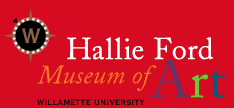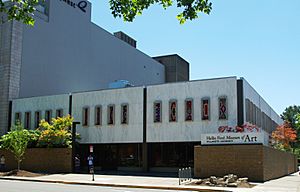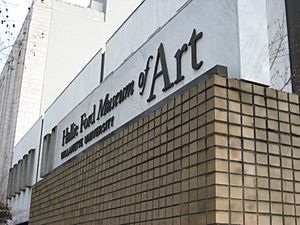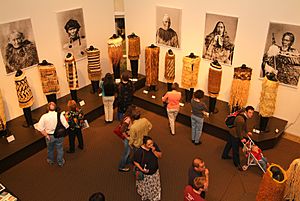Hallie Ford Museum of Art facts for kids
 |
|
| Lua error in Module:Location_map at line 420: attempt to index field 'wikibase' (a nil value). | |
| Established | 1998 |
|---|---|
| Location | Salem, Oregon, United States |
| Type | private: art |
| Visitors | 30,000 (2003) |
The Hallie Ford Museum of Art (HFMA) is a cool art museum at Willamette University in Salem, Oregon, United States. It is one of the biggest art museums in Oregon! It opened in 1998 and is right across the street from the Oregon State Capital building. The museum shows off amazing art and historical items, especially things related to Oregon artists. They also have special traveling exhibits in some of their six galleries.
Museum History
Before the Hallie Ford Museum opened, Willamette University already had many art pieces. These were gifts to the university over the years. By 1896, these collections were kept in a museum on the fourth floor of Waller Hall. Later, around 1940, the museum moved to the second floor of the gymnasium. At that time, the collection included things like birds, old documents, minerals, and Native American artifacts.
In 1990, the school received a big gift of about 250 pieces of ancient, European, Middle Eastern, and Asian art. This came from the Sponenburgh family. In 1992, a former student named Dan Schneider suggested that the school should have a proper museum. Then, in 1994, Roger Hull, an art faculty member, asked the school's leaders to create an art museum.
Over the next two years, plans were made, and donations came in. A very important donation came from Hallie Ford and the Ford Family Foundation. This money helped the university buy and fix up a building for the museum. The museum officially opened in 1998 with over 3,000 pieces of art. It was the second largest art museum in Oregon at that time.
People in the local area voted the museum as the best fine arts place in 2002. In 2003, it won an award from the Oregon Art Education Association. It was also named the third best art gallery in Oregon's mid-Willamette Valley region. About 16,000 people visited the museum in its first full year. By 2003, around 30,000 people visited each year.
In July 2007, the museum started a project to add more storage space. This $850,000 project finished in December 2007. The money for this came from a gift by Maribeth Collins. Also in 2007, the museum received a grant from the National Endowment for the Arts. This money helped fund an exhibit called "The Art of Ceremony." It showed tribal ceremonies of Native American tribes in Oregon. In 2013, the museum presented "Breath of Heaven, Breath of Earth," which was its biggest exhibit yet.
The museum is also part of the Monuments Men and Women Museum Network. This network started in 2021.
Museum Building
The building where the museum is located was built in 1965. It was first used by a phone company called Pacific Northwest Bell. This building has three floors, with two above ground. It has about 27,000 square feet of space. A local architect named James L. Payne designed it. In 1996, Willamette University bought the building. The university then remodeled it from 1997 to 1998. Jon Wiener of Soderstrom Architects helped with the design.
The museum building opened on October 3, 1998. It has a two-story gallery space inside. There are also curved walls, marble panels, and a private garden outside. The building has brick on the outside and a patio made of slate. The museum has six galleries in total. Four of these galleries show the museum's permanent collections. The other two galleries are used for special traveling exhibits. In 2008, colorful panels were added to the second-floor windows. These panels make the outside of the building more colorful. Some of them even light up from the inside!
Art Collections
The Hallie Ford Museum of Art has many different kinds of art. These artworks come from various cultures and time periods. The six galleries show art made with different materials. You can see sculptures, paintings, baskets, and prints. The art includes Native American art, European paintings, American art, and contemporary art. The museum also highlights art and artists from Oregon.
The Confederated Tribes of the Grand Ronde Gallery has beautiful baskets. These baskets were made by Native American tribes in the Pacific Northwest. They are from collections gathered in the 1940s. The museum also has the Carl Hall Gallery. This gallery shows a variety of artworks, including pieces by former teachers at the university.
Other galleries include the Melvin Henderson-Rubio Gallery, which hosts traveling exhibits. The General Collections Gallery displays art from Asia and Europe. The Study Gallery shows smaller, temporary collections. And the Print Study Room has prints and photographs.
The museum owns two paintings by the German landscape painter Frederick Ferdinand Schafer. These paintings are called Morning in the Adirondacks and Olympic Mountains, Washington. The museum got them in 1996. Other art pieces include Egyptian art, Korean art, African art, and Indian art. There are also etchings by the Dutch artist Antonie Waterloo. The museum also has the Paulus Collection. This is a collection of old photograph negatives of the Salem area from the early 1900s.
The Hallie Ford Museum of Art is a member of two important groups. These are the American Association for State and Local History and the American Alliance of Museums. As of 2005, the museum had an endowment of $4.5 million. An endowment is money set aside to help support the museum for a long time.
Past Art Exhibits
The museum has shown many interesting exhibits over the years. In 1999, works by Seattle painter Michael Spafford were featured. In 2005, the museum showed a collection of works by Portland artist Michael Brophy. In 2007, the museum had a show featuring art by Oregon painter Amanda Snyder.
Other exhibits have included works by artists like Rick Bartow, Jacob Lawrence, and Fay Jones. The museum has also hosted traveling exhibits. These included an exhibit on Egyptian art in 2002. It was also one of only three places in the U.S. to host the "Toi Maori: The Eternal Thread" exhibit. In 2007, it showed a collection of ancient glass. It also displayed ancient Roman and Greek artifacts. In 2011, an exhibit called AMERICANA by Ross Palmer Beecher was shown.
About Hallie Ford
Hallie Ford was one of the people who started the Ford Family Foundation. She went to college in Oklahoma and then moved to Oregon. In 1975, Hallie Ford became a trustee at Willamette University. She was married to Kenneth W. Ford. Together, they built the Roseburg Forest Products Company in Roseburg, Oregon, starting in 1936. From this, they later created a foundation. This foundation grew to become the Ford Family Foundation in 1996. Hallie Ford passed away on June 4, 2007, when she was 102 years old.




